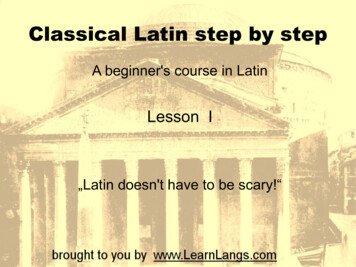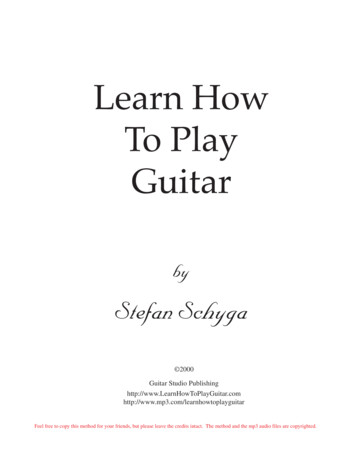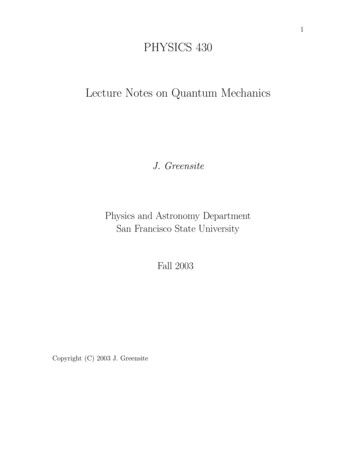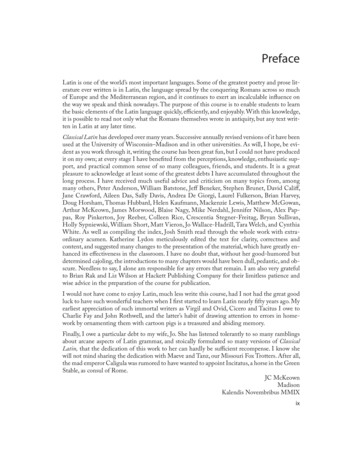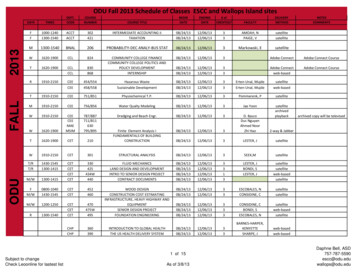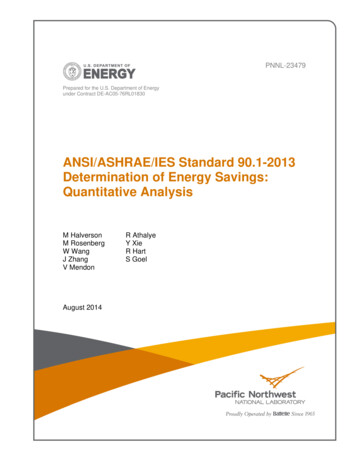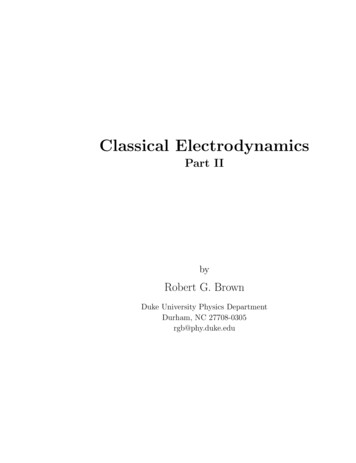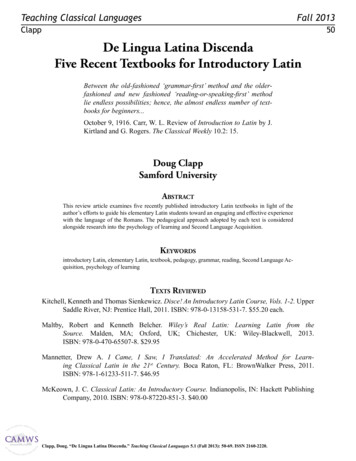
Transcription
Teaching Classical LanguagesFall 2013Clapp50De Lingua Latina DiscendaFive Recent Textbooks for Introductory LatinBetween the old-fashioned ‘grammar-first’ method and the olderfashioned and new fashioned ‘reading-or-speaking-first’ methodlie endless possibilities; hence, the almost endless number of textbooks for beginners.October 9, 1916. Carr, W. L. Review of Introduction to Latin by J.Kirtland and G. Rogers. The Classical Weekly 10.2: 15.Doug ClappSamford UniversityAbstractThis review article examines five recently published introductory Latin textbooks in light of theauthor’s efforts to guide his elementary Latin students toward an engaging and effective experiencewith the language of the Romans. The pedagogical approach adopted by each text is consideredalongside research into the psychology of learning and Second Language Acquisition.Keywordsintroductory Latin, elementary Latin, textbook, pedagogy, grammar, reading, Second Language Acquisition, psychology of learningTexts ReviewedKitchell, Kenneth and Thomas Sienkewicz. Disce! An Introductory Latin Course, Vols. 1-2. UpperSaddle River, NJ: Prentice Hall, 2011. ISBN: 978-0-13158-531-7. 55.20 each.Maltby, Robert and Kenneth Belcher. Wiley’s Real Latin: Learning Latin from theSource. Malden, MA; Oxford, UK; Chichester, UK: Wiley-Blackwell, 2013.ISBN: 978-0-470-65507-8. 29.95Mannetter, Drew A. I Came, I Saw, I Translated: An Accelerated Method for Learning Classical Latin in the 21st Century. Boca Raton, FL: BrownWalker Press, 2011.ISBN: 978-1-61233-511-7. 46.95McKeown, J. C. Classical Latin: An Introductory Course. Indianopolis, IN: Hackett PublishingCompany, 2010. ISBN: 978-0-87220-851-3. 40.00Clapp, Doug. “De Lingua Latina Discenda.” Teaching Classical Languages 5.1 (Fall 2013): 50-69. ISSN 2160-2220.
Teaching Classical LanguagesFall 2013Clapp51Minkova, Milena and Terence Tunberg. Latin for the New Millennium: StudentText, Levels 1-2. Mundelein, IL: Bolchazy-Carducci Publishers, Inc., 2008.ISBN: 978-0-86516-560-1. 75.00 each.Each fall, I walk into my Elementary Latin classroom with great hopes of introducing thestudents to the voices of the Romans and of all who have expressed beautiful and powerful ideasin the Latin language. Each summer, I ponder how, next time, I will finally teach in such a waythat I promote the genuine learning that seems to have largely slipped away with the academicyear. Yes, my dreams are dashed on the complexity of Latin compressed into two semesters, eightyclasses, fewer than one hundred hours. Yes, I am trying to woo students whose flat expressionsindicate that, for most, my course is an annoying hoop on the path to a career credential. But I amdetermined for Vergil to have his day. I want to provoke the curiosity of the class and to meet thatcuriosity with a clear approach to developing a dawning comprehension of Latin.Because a large majority of my students arrive motivated only by a curricular checklist, Iwant and need them to decide, and quickly, that Latin makes sense and that the sense it makes isworth their investment of time and energy. So I have been learning in general about how the human brain learns (e.g. Ambrose et al.) and in particular about how the human brain can acquire asecond language (e.g. Lightbown and Spada; Burns and Richards), and I am working to implementpractices grounded in the psychology of learning that promote comprehension by working withrather than against the brain’s cognitive processes. I would like help accomplishing this from thetextbook I ask students to buy, since creating sufficient teaching and learning materials ex nihilolooms as a Sisyphean labor. Thus, I am constantly trolling for useful materials from publishers ofLatin textbooks. Their introductory works typically fall into one of the two camps that date back toat least the World War I-era epigraph for this article, into the division between grammar-first andreading-first approaches. This century-old conversation within Classics continues to inform ourdiscussions of Latin pedagogy, but I need a textbook that also heeds the relevant findings of currentresearch into learning and language acquisition.1Although a textbook cannot bear the blame for my own limitations, I do want more fromthe textbooks that I have used over the years. Evidence suggests that I am in good company, astextual frustration seems to be a conversational staple in our profession (Johnson 246; May 151;Verger). I cannot complain, however, about the lack of choice. Table 1 outlines twenty-three options.2 Seven of these were first published in the twenty-first century—colleagues productivelydistilling their dissatisfaction with the available choices into a new addition to the corpus (e.g.Keller xvii; Mannetter 3). In this article, I will examine five recent offerings in light of my own efforts to resolve a nagging sense that I should be guiding students down a more engaging and moreeffective path to an encounter with Latin. I will first provide an overview of the works in question,then I will set out my pedagogical premises, and I will conclude by considering the textbooks inlight of my initial encounters with the science of learning.1 Carlon provides a clear overview of some principles of Second Language Acquisition. Classics need more of this,both incorporating research on learning languages and generating empirical data within our own discipline. I confessmy own limited awareness of the current state of affairs, and my initial explorations have found daunting the actualand virtual shelves filled with contributions to the field of language learning, much of it written in technical prose.2 My own search, which began at the now silent LATINTEACH blog, affirms the usefulness Judith Sebesta’s annualtextbook survey in Classical World.
Teaching Classical LanguagesFall 2013Clapp52Table 1. Elementary Latin Textbooks 2013 Wiley’s Real Latin: Learning Latin from the Source (Maltby and Belcher, Wiley) 2011 Disce! An Introductory Latin Course (Kitchell and Sienkewicz, Pearson) 2011 I Came, I Saw, I Translated (Mannetter, BrownWalker) 2010 Classical Latin: An Introductory Course (McKeown, Hackett) 2008 Latin for the New Millennium (Tunberg and Minkova, Bolchazy-Carducci) 2013 Introduction to Latin 2nd ed. (Shelmerdine, Focus) 2003 Learn to Read Latin (Keller and Russell, Yale) 2012 Oxford Latin College Edition (Balme and Morwood, Oxford) 2011 Wheelock’s Latin 7th Edition (LaFleur, HarperCollins) 2009 Ecce Romani, Fourth Edition (Prentice Hall/Pearson) 2007 Latin For Americans (Ullman et al., Glencoe/McGraw-Hill) 2007 Latin Alive and Well (Chambers, University of Oklahoma Press) 2011 New First Steps in Latin 2nd ed. (Klaasen et al., Focus/Pullins) 2002 Lingua Latina (Traupman, Amsco) 2001 Cambridge Latin Course, Fourth Edition (Pope et al., Cambridge) 1997 Reading Classical Latin (Ball, McGraw Hill) 1986 Reading Latin (Jones and Sidwell, Cambridge) 1986 Latin for Reading (Knudsvig et al., University of Michigan Press) 1982 Latin Via Ovid (Goldman and Nyenhuis, Wayne State Univ. Press) 1977 Latin: An Intensive Course (Moreland and Flesicher, University of California Press 2011 Lingua Latina per se Illustrata (Ørberg, Focus) 1990 The Jenney Latin Program (Pearson) 1995 Latin Course for Schools (Wilding, Bloomsbury)Textbook OverviewIn Latin for the New Millennium, Milena Minkova and Terence Tunberg have produced alavishly published and comprehensive series for introductory Latin (Bolchazy-Carducci 2008).Two hardback texts, Level 1 and Level 2, introduce the grammar with readings, exercises, cultural information, and abundant images. Each volume is supported by a workbook, audio files,a massive teacher’s manual, and two enrichment texts by Rose Williams, one on history and oneon mythology. As proclaimed in the marketing material, this system aims to combine “the bestpractices of the reading method and the traditional grammar approach” into a “fusion approach toLatin.”
Teaching Classical LanguagesFall 2013Clapp53Level 1 contains twenty-onechapters with seven review sections,while Level 2 has fifteen chapters andfive review sections along with tenreadings from the Life of Atticus byCornelius Nepos. Each chapter openson a beautiful full-color page with animage and a quotation (MemorābileDictū) anticipating the subsequentreading passage (see Figure 1). Thatpassage, adapted from a Latin author,contains several new but unmarkedgrammatical elements that will thenbe explained (Language Facts) andpracticed in exercises. A list of Vocabulary to Learn follows the first pointof grammar, and the chapter concludes with a dialogue among modernstudents which is designed to promotethe “oral element of language learning” and to become “a bridge betweenthe lives of modern students” and theancient authors (TM viii). After eachset of three chapters, a review sectionrevisits the vocabulary, sets additionalgrammar exercises, and presents three Figure 1. Latin for the New Millenium, Chapter 7,essays exploring the cultural contextp. 1.111of Latin literature and connecting it tocontemporary concerns. The Level 2 text adds to each chapter an unadapted but annotated selection from the Life of Atticus by Cornelius Nepos.Three elements set Latin for the New Millenium apart from a typical introduction to Latin.First, the course encompasses the whole of our Latin heritage. Level 1 uses the adapted readingsto provide a chronological survey from Plautus and Terence up to Augustine and Boethius. Level2 continues the adapted readings from the medieval writings of Bede and Einhard on to the neoLatin of Copernicus and The Underground Journey of Nicolaus Klum by Ludvig Holberg (16841754). The cultural essays maintain this broad perspective, exploring topics from Roman slaveryto the scientific revolution.Second, the series encourages conversation in Latin, starting with the modern dialoguesthat conclude each chapter. More significantly, the Teacher’s Manual facilitates the practice oforal comprehension and production with multiple exercises constructed for each chapter. A scriptis provided, so teachers need not speak extemporaneously in Latin. These exchanges range fromtransformation (e.g. TM1.182 Change the plural form into the singular. Teacher: aedificābāmus.Expected response: aedificābam) to comprehension (e.g. TM1.257. Teacher: Quis ad vīllam venit? Expected response: Seneca ad vīllam venit). Also available for purchase are MP3 files of theadapted passages read by Anna Andresian and Professor E. Del Chrol.
Teaching Classical LanguagesFall 2013Clapp54Third and last, the authors and publisher have created an extensive network of support.Each level has a thick, legal-sized, spiral-bound Teacher’s Manual that reprints every page of thetextbook alongside notes, tips, activity suggestions, exercise answers, passage translations, andoral exercises. An online Teacher’s Lounge for registered instructors offers free downloads ofreproducible worksheets, answer keys, test banks, maps, and more, and it also hosts a forum andblogs to encourage sharing instructional ideas and resources.Jim McKeown breathes fresh air into the traditional Grammar-Translation approach inClassical Latin: An Introductory Course (Hackett Publishing 2010) with the addition of vocabulary reinforcement, brief reading passages with comprehension questions, some creative exercises, and a generous portion of whimsy in the porcus who consistently appears in examples ofsyntax (see Figure 2). Each chapter opens deductively with an introduction and explanation ofgrammatical concepts, accompanied by charts and illustrative sentences. Practice exercises andreadings (Prōlūsiōnēs) centered on the new grammar and vocabulary follow, and the chapter concludes with some fun (Lūsūs) exploring derivatives (Thēsaurus Verbōrum) and Roman cultureFigure 2. Classical Latin, Chapter 21, p. 245
Teaching Classical LanguagesFall 2013Clapp55(Vīta Rōmānōrum). More exercises populate the separate Workbook, which includes a key forself-correction, and a website presents a potpourri of learning resources.The clear repetition of these elements exhibits an attractive simplicity, as do the twentyeight chapters, which permit an uncomplicated division of a chapter per week for a two-semestercollege sequence. That reasonable pace is supported by a text that is easy to read, with ample roomon the 8½ x 11 inch pages. Page headers indicating chapter number and grammatical subject letyou know where you are, while bold headings visibly divide the chapter sections.Disce! by Ken Kitchell and Tom Sienkewicz (Prentice Hall/Pearson 2011) has been carefully constructed to fulfill the Standards for Classical Language Learning by building on the foundation of a continuous narrative newly written for the text. This element of the reading method,however, is married with a more traditional presentation of grammar because the authors findpedagogical value in both approaches (I.xix). Disce! has two relatively slim volumes incorporatingreading, grammar, and culture, supported by two workbooks, audio files, a subscription website,and two PDF Instructor’s Resources Manuals containing a wealth of teaching materials.The twenty chapters in each volume present two 250-word reading passages (Lectiō Prīmaand Lectiō Secunda), each preceded by pre-reading material and followed by the explanation ofnew morphology or syntax (Grammatica A and B). Each chapter concludes with sections considering salient cultural information (Mōrēs Rōmānī), the influence of Latin today (Latīna Hodierna),the geography of the Roman world (Orbis Terrārum Rōmānus), and a deeper look into the chapter’s grammar (Angulus Grammaticus). The text, though using smaller type, is attractively printedwith distinct headings and effective use of color and images.Disce! distinguishes itself first by its three-pronged approach to grammar. New conceptsare briefly previewed before a reading passage. After the reading (see Figure 5), the concept isfully explained. The chapter ends with additional grammatical explanation of aspects deemed useful but not essential to reading. The series also offers tremendous support for the classroom, including three suggested syllabi for utilizing the Disce! materials in two or three semesters withfour or five meetings per week. A unique feature of Disce! is MyLatinLab, an online subscriptionto practice and review materials. This learning management software, parallel to a broader productlike Blackboard or Moodle, presents a digital version of the exercises from the Student ActivityManual.A bold approach informs I Came, I Saw, I Translated: An Accelerated Method for Learning Classical Latin in the 21st Century by Drew A. Mannetter (BrownWalker Press 2011), whichsquarely faces the dilemma of teaching the Latin language while introducing an authentic Romanvoice within the constraints of a one-year language requirement. Students dive immediately intothe first chapter of Caesar’s Gallic War, and the unadapted text determines the introduction of morphology, syntax, and vocabulary. The whole of the first paragraph is presented to open Pars Primaand is then broken down into eight sentences, which are broken down into clauses, which are broken down into the constituent words. Students focus on the form, meaning and syntax of one wordat a time and then work upward to translate the clause, the sentence and the paragraph (see Figure3). This procedure continues in Pars Secunda (BG 2), while Pars Tertia (BG 4, 5, 24-28) presentssentence and clause, but not individual words. Caesar begins his work Gallia est omnis dīvīsa inpartēs trēs, so students first meet Gallia, which introduces them to the concepts of noun, inflection,
Teaching Classical LanguagesFall 2013Clapp56Figure 3. I Came, I Saw, I Translated, Chapter 10, p. 186declensions, case, number, gender, and then to the paradigm of the first declension. Worksheetsresiding in Appendix B are assigned to provide additional practice of the grammatical concepts.Because Caesar’s account of his campaign against the Helvetians organizes this introduction to the Latin language, the demonstrative pronoun hic occurs on Page 81 in Sentence 2 of Paragraph 1, while the demonstrative pronoun ille appears as the last grammatical item on Page 325 inSentence 5 of Paragraph 28. The Endnote alerts the student preparing for further study that threemajor points of grammar have not appeared in the text: the imperative mood, the future tense, andthe future perfect tense. These grammatical idiosyncrasies are the trade-off for immersing studentsin a meaningful text. Students also encounter the larger context with English-language readingassignments for the whole of the Gallic War (not included), supplemented by study questions inAppendix E. A single volume contains the text and grammatical explanations, along with glossary(Appendix A), reference grammar (Appendix C), and more. Thorough tables of contents, one forthe whole book and one to begin each section, lay a clear map of the ground to be covered. I find,however, that the lack of a content header on each page impedes navigation, as do the denselyprinted, numbered but not titled, grammatical explanations. By contrast, a dark box with whitenumbers makes it easier to identify the sentence and word under consideration in the first twoparts, though the third part abandons this device.Wiley-Blackwell has entered the market with the Grammar-Translation approach of Wiley’sReal Latin by Robert Maltby and Kenneth Belcher (2013). Its intensive approach relies for its readings exclusively on sentences and passages unchanged from their ancient Roman sources. Twentyone chapters outline the morphological and syntactical patterns encountered in Latin texts, and thegrammatical explanations are frequently accompanied by a “Try This” section providing morphological practice via parsing, constructing forms, and translating single words to and from Latin. Allchapters after the first have nine Latin sentences for translation into English (see Figure 4) as well
Teaching Classical LanguagesFall 2013Clapp57as nine English sentences for translation back into theiroriginalLatin.BeginningwithChapter 13, chapters conclude withlonger, unadaptedreading passagesof ten to twentylines. This shift atChapter 12 reflectsthe authorial intention of a mid-yearbreak, twelve chapters in the first semester followed bynine in the second.They explain theirstrategy in the introduction to an Instructor’s Manual,available online forFigure 4. Wiley’s Real Latin, Chapter 10, p. 116registered teachers.This document also contains a melange of pedagogical resources, including teaching tips, additional examples of complicated syntax, answer keys for the exercises, and further reading passages. The online component features a growing library of resources and directs students to www.quizlet.com for digital vocabulary flashcards.Table 2. Textbook Features.TextbookLatin for the New MillenniumClassical LatinDisce!I Came, I Saw, I TranslatedWiley’s Real Latinworkbookweb exercisesconversationaudio esnonoyesyesyesnonoPedagogical PremisesI preface my evaluation of these five recently published textbooks by echoing the consensus that the learning in a Latin classroom has as its central goal reading authentic literature (Distler1, Mannetter 4, May 150)3 within the broader context of the Standards for Classical LanguageLearning.3 Wooten (186) questions the feasibility of this goal in such a compressed timeframe, and I heard a similar sentimentexpressed at the 2012 meeting of the Alabama Classical Association.
Teaching Classical LanguagesFall 2013Clapp58I want my students to find the meaning that can be lost in translation, so all of the workteaching and learning the forms and functions of words in the Latin language should be means tothe ultimate end of understanding ideas expressed in Latin. If my students do learn to read authentic Latin texts, their reading will not result from continuously, consciously applying rules of syntax(McCaffrey 116). Instead, as reading uncovers meaning mediated through a written text, studentsshould experience Latin as an act of communication, not as a corpse for dissection. A painful moment in my Elementary Latin stand-up routine finds me saying, “Latin does not communicate one[pause] word [a second pause] at [more interminable pausing] a time.” Ideas, not individual words,occupy the attention of experienced Latin readers, so novices should likewise focus on ideas. Nordo I want my students to understand reading Latin as a treadmill of perpetual translation. I am alsoin the habit of asking a confident student with a good sense of humor, “What does this Latin passage say in English?” I make sure that this is an impossible task beyond the competence of the student, and when the student hesitates and then bravely stumbles forward, I step in with, “It doesn’tsay anything in English. It says something in Latin.” I chuckle, my students groan.My course and its textbook should offer students the potential for future fluency by promoting deep learning of how Latin communicates. That learning experience belongs to students andtakes place through actual changes to the neural connections housed inside their crania. All of myteaching cannot ‘learn’ my students the morphological, syntactical and lexical awareness that canopen a door to Vergil’s epic or Cicero’s oratory. Any learning that does occur will successfully harness cognitive processes operating in the brains of our students. As you may have heard,a critical condition for the acquisition of new knowledge is the existence of prior knowledge, which can be built in a mental model or“schema.” Formation of “schemas” is a central event in studentcentered active learning, by which mental models are constructedand reconstructed Recently, evidence has been obtained that newinformation processed by the hippocampus can be consolidated intoa stable, neocortical network more rapidly if this new informationfits readily into a “schema.” (Ruiter, van Kesteren, and Fernandez225)Like you, I want Latin consolidated into a stable, neocortical network, the more rapidly the better.From which I deduce that I need students to construct mental models that employ prior knowledgeto promote the acquisition of Latin. New morphological, syntactical, and lexical information aboutLatin needs to connect to what students already know. The research-based principles for teaching published in How Learning Works make practical this science of learning (Ambrose et al.).Students need to be able to organize what they learn into mental structures that are “well-matchedwith the way that knowledge needs to be accessed and used” (Ambrose et al. 49). Students willmove toward mastery of reading Latin when they “acquire component skills, practice integratingthem, and know when to apply what they have learned” (Ambrose et al. 95). At the heart of thisenterprise lies “goal-directed practice coupled with targeted feedback” (Ambrose et al. 125). Mapping these tested truths about how the brain learns on to the process of communication with anemphasis on reading should drive the approach I and my textbook adopt for introducing students tocomprehending ideas expressed in Latin. What are the component skills if we move beyond, “agricola, agricolae, agricolae.”, and what sort of activities will connect form, function, and meaning? Although much of this thinking will reveal that effective teaching practices have been handed
Teaching Classical LanguagesFall 2013Clapp59down because they are effective teaching practices, I cannot assume that the way I learned Latinis the way I need to teach Latin. And I need every trick in the book to inculcate real learning instudents whose goals do not include a doctorate in classical philology.ReadingFrom day one, students should have confidence that words written in Latin can make sense.Meaningful comprehension stands as the central goal for accessing and using the knowledgelearned about Latin, and plentiful reading offers the best opportunity to integrate those component skills. Since communication is the end to which the formal grammar is only the means, themorphological and syntactical elements of Latin are not enough—the pieces need to fit together,and ample reading demonstrates for students that the pieces can and do fit together. That requiresan abundance of meaningful input. Isolated sentences can offer useful, targeted practice, but continuous passages deliver the abundance that encourages reading comprehension, reading from leftto right, and efficient reading strategies.4 In Stephen Krashen’s words, “Reading is the only way,the only way we become good readers, develop a good writing style, an adequate vocabulary,advanced grammatical competence, and the only way we become good spellers” (20). AlthoughKrashen’s insistence on the necessity and sufficiency of reading apart from direct instruction hasnot been sustained by empirical research (Carlon 107), the fundamental premise that readers needto read stands (Fernández 156-7).My rough calculations indicate that Disce! presents students with 20,000 words of connected prose from a single narrative of created Latin about a patrician family and a plebeian familyliving in Rome in 9 BC; Latin for the New Millennium with 10,000 words from adapted passagesin a chronological survey of our Latin inheritance with another 2,000 of unaltered Nepos; andClassical Latin with 4,000 words in passages selected independently of each other for their intrinsic interest and their grammatical suitability. I appreciate that all three establish the context forthe passage, provide lexical support within view of the passage and pose questions that privilegecomprehension over translation. Wiley’s Real Latin waits until Chapter 13 and the second semesterto introduce 1,500 words in connected readings of unadapted Latin poetry. I Came, I Saw I Translated uses about 1,200 words of Caesar’s Bellum Gallicum but proceeds by disconnecting thatconnected prose into its component pieces.My own experience using the 1,750 words of Eutropius found in Beyer’s War With Hannibal as a supplementary weekly reading in the second semester of Elementary Latin convinces methat more is more. With appropriate cultural and lexical support and without stopping to analyzeevery word, connected passages let students read for meaning (Gruber-Miller 1998: 171). Thisshould encourage deep learning because it can help them structure what they have learned for itstrue purpose, comprehension, and because it provides plentiful practice in the necessary integration of component skills.VocabularyThe acquisition of sufficient vocabulary stands as a fundamental skill for Latin studentsbecause lexical awareness remains a key component in language acquisition (Richards and Rogers4 Teaching fluent reading rather than piecemeal decoding has entered the recent classical conversation with the workof Hoyos and later Gruber-Miller, McCaffrey and Lister. Kitchell has alerted us to the inescapable importance ofcultural context. Outside of our discipline, the nature of learning to read a second language has generated its ownextensive bibliography, e.g. Bernhardt, Hudson, and Koda.
Teaching Classical LanguagesFall 2013Clapp60138).5 Morphological and syntactical competence can help a Latin student analyze the potentialfunctions of a Latin word ending in ‘-ī’:NOUNS Genitive Singular Dative Singular Ablative Singular Nominative Plural Locative Vocative Singular Vocative PluralVERBS Present Singular Imperative Present Passive Infinitive Perfect Active First SingularBut sorting through possibilities is not reading, and a strong vocabulary can preclude such ambiguity. When I audited a course in Biblical Hebrew at Samford’s Beeson Divinity School in 20102011, I was introduced to the relatively simple system of prefixes and suffixes for verbs alongwith the complexity of Masoretic vowel pointing. I have discovered that recognizing the stemallows me to quickly and even unconsciously recognize the form before I come to grips with thevowel points. I suspect that is true for Latin students, so I want to do more than present a list ofwords with the commandment, “Go and Memorize.” Too many of my students have stumbled overthe brute application of memory, so my textbook and I need to deploy the science of learning todevelop a strategy for constructing a framework that connects new Latin words to what studentsalready know (Distler Chapter 4). Word frequency lists should help determine which words we askstudents to invest their mental energy in learning (Muccigrosso; Francese).6 The selected wordsshould be learned at a sustainable pace. Images, derivatives, and word families should help connect these Latin words to prior knowledge, and Latin sentences containing new vocabulary, aswell as English sentences with the target word in Latin, will situate each new item in a meaningfulcontext. Above all, the targeted words should appear frequently in reading.Disce! and Latin for a New Millennium make an intentional effort to support vocabularyacquisition. LNM has geared its vocabulary selection for the Advanced Placement examinations,while Disce! has consulted several frequency lists to determine which words students should commit to memory (1.xxi). Both textbooks present in every chapter a list of twenty to twenty-fivewords intended for learning that is distinguished from additional vocabulary printed to assist inreading a passage. Each also offers vocabulary exercises based on derivatives in the book as wellas in the printed and online workbook material. LNM’s Teacher’s Manual recommends some basic5 Vocabulary, like reading, is the focus of research in the field of Second Language Acquisition.6 I regularly and gratefully return for guidance on vocabulary to the hard work of the Resources page a
Teaching Classical Languages Fall 2013 Clapp 52 Table 1. Elementary Latin Textbooks 2013 Wiley’s Real Latin: Learning Latin from the Source (Maltby and Belcher, Wiley) 2011 Disce!An Introductory Latin Course (Kitchell and Sienkewicz, Pearson) 2011 I Came, I Saw, I Translated (Mannetter, BrownWalker) 2010 Classical
